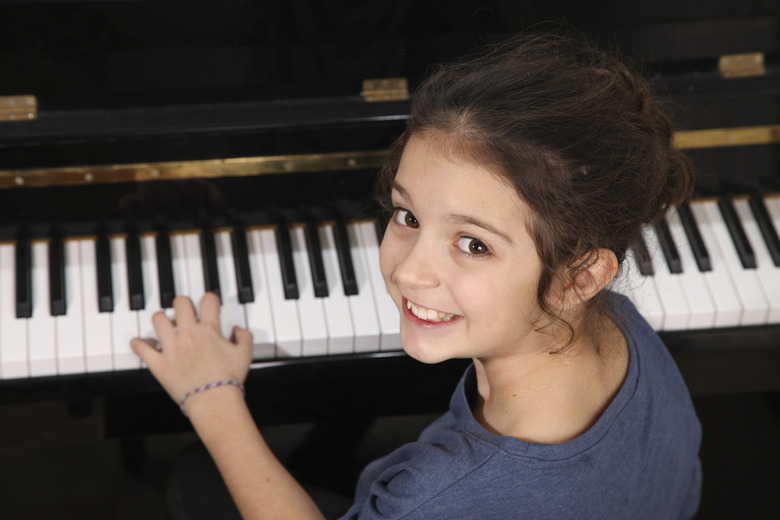Music Experiments For Kids
Incorporating musical activities and experiments into the classroom is an excellent way to introduce students to music and the science of sound. You can do a variety of activities with elementary school-aged kids, ranging from making homemade instruments to observing the behavior of sound waves.
Make Your Own Drum
Make Your Own Drum
This activity enables students to make their own sounds, using a homemade drum. You need a rubber band, a pen or pencil, a plastic bowl and a sheet of waxed paper large enough to cover the top of the bowl. To assemble the drum, lay the waxed paper across the top of the bowl and secure it with the rubber band. Have the students use pens or pencils as drumsticks that they'll use to strike the wax paper. Ask the students to think about different types of drums such as marching-band drums, which make a deep, booming sound and little, lap drums, which make higher sounds. This activity is ideal for kindergarten students and first graders to introduce how sound is created and how different sized instruments make different sounds.
Musical Straws
Musical Straws
This activity allows the students to produce their own musical sounds by making a straw clarinet. All you need are plastic straws and scissors. Have the students flatten one end of a straw with their teeth and then snip off the corners of the flattened end. Then, instruct them to place the flattened end in their mouth and blow. Doing this should produce a sound. Explain that this is very similar how wind instruments — such as clarinets and oboes — work. The flattened end of the straw vibrates when you blow into it, and as the vibrations travel down the straw, they create sound. Cut away parts of the straw as they blow; they will notice that the pitch changes as the straw gets shorter and shorter.
Movement of Sound Waves
Movement of Sound Waves
This activity serves as a great visual that shows how sound waves move through the air. It's ideal for second and third graders, and introduces them to the scientific side of sound. For this experiment, you need a round, medium-sized bowl filled half-way with water, ground black pepper and liquid dish-washing soap. Sprinkle some black pepper into the bowl until an even layer of pepper covers the entire surface of the water. Then, carefully pour one drop of the liquid dish-washing soap in the middle of the bowl. Have the students observe what happens — the black pepper will move away from the center of the bowl. The black pepper represents sound waves. Tell the students to imagine a speaker in the center of a room and that when music comes out of a speaker, it travels away from the speaker to the rest of the room, just as the pepper travels away from the soap.
Music With Water
Music With Water
This activity is ideal for second-grade students and higher. You will need five or more drinking glasses or bottles filled with differing amounts of water and a wooden stick or pencil. Line up the glasses on a table and have the students gently tap the glasses with the stick, starting with one glass and proceeding to the next, until they have tapped all the glasses. Discuss what the students observe. Probably, they will say that each glass makes a different tone. The glass that had the greatest amount of water had the deepest tone and the glass that had the least amount of water had the highest tone. Explain that when you strike the glass, you create sound waves that travel through the water. When a glass has more water in it, that greater amount of water slows down the sound waves, resulting in a lower tone. A smaller amount of water enables the sound waves to move more quickly, resulting in a higher tone. In relation to music, this is the same phenomenon that occurs with instruments. For example, shorter, tighter strings on a standard violin create a much higher sound than the long, looser strings of a bass violin.
Cite This Article
MLA
Walcott, Kat. "Music Experiments For Kids" sciencing.com, https://www.sciencing.com/music-experiments-kids-7832008/. 24 April 2017.
APA
Walcott, Kat. (2017, April 24). Music Experiments For Kids. sciencing.com. Retrieved from https://www.sciencing.com/music-experiments-kids-7832008/
Chicago
Walcott, Kat. Music Experiments For Kids last modified March 24, 2022. https://www.sciencing.com/music-experiments-kids-7832008/
